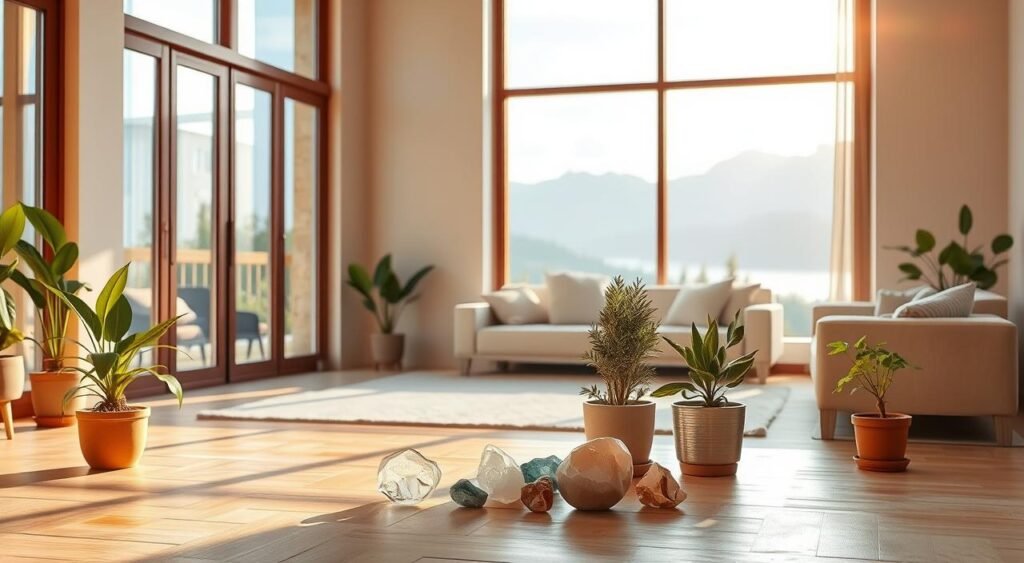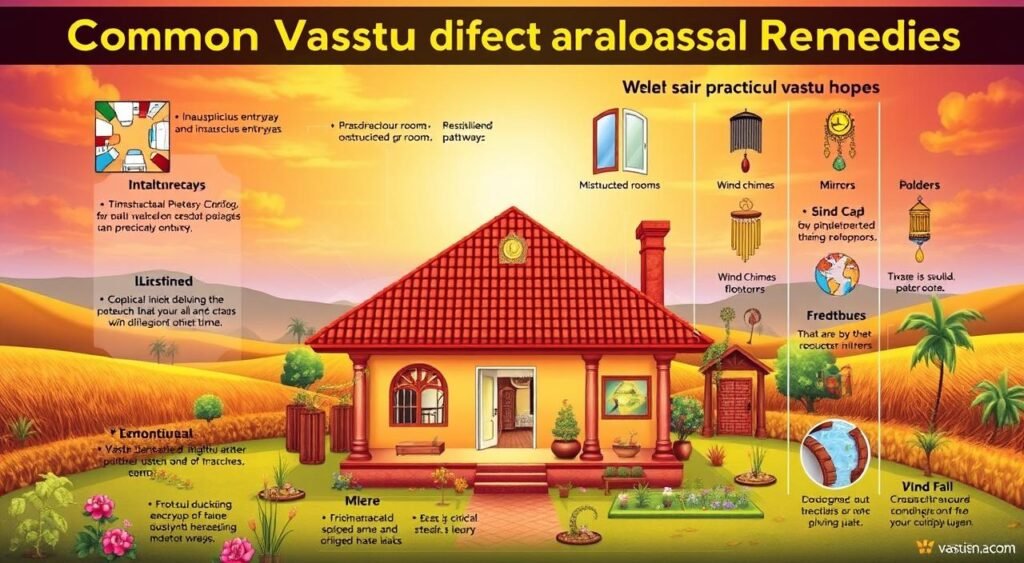Did you know your body is 60% water—mirroring Earth’s 75% surface water coverage1? This shared connection isn’t accidental. Vastu Shastra, the ancient science of space design, teaches that harmony between Earth, Water, Fire, Air, and Space elements in homes directly impacts health, success, and peace. When misaligned, these forces disrupt daily life, but balanced properly, they amplify well-being1. These five elements also shape our senses and body balance, as Ayurveda reveals: imbalances here lead to physical and emotional struggles2
From ancient temples to modern homes, Vastu principles ensure every space reflects universal energy patterns. For instance, the kitchen’s southeast placement balances fire and space energies, while open centers channel sound-based space element vibes1. By aligning these forces, you invite positive energy flows that support health, prosperity, and clarity. Let’s explore how science and tradition unite to create spaces that nurture life itself12.
Key Takeaways
- Human and planetary elements mirror each other, with water dominating both1.
- Vastu Shastra uses element placement to balance energy, like fire in kitchens1.
- Ayurveda ties element imbalances to health issues, Vastu addresses this through space design2.
- Open centers and directional zones maximize element energy flow1.
- Aligning homes with these forces enhances productivity, relationships, and vitality1.
Understanding Vastu Shastra and Its Ancient Origins
Vastu shastra, an ancient architectural system, originated in India over 5,000 years ago, rooted in Vedic texts like the Rigveda and Atharvaveda3. Its principles guide vastu for home design to balance energy through natural elements like earth, water, and air.
The Historical Roots of Vastu in Vedic Tradition
Early Vastu texts like the Arthashastra (2nd century BCE) and Brihat Samhita (6th century CE) detailed temple and city layouts, influencing Jaipur’s planned streets and landmarks like the Jawahar Kala Kendra4. These texts emphasized harmony with nature, linking building orientation to magnetic fields and sunlight patterns4.
How Vastu Differs from Feng Shui
“Vastu prioritizes elemental balance rooted in Hindu cosmology, while Feng Shui focuses on Chi energy from Taoist philosophy.”
Unlike Feng Shui’s Chinese origins, Vastu aligns spaces with India’s geography and Vedic rituals. Both aim for harmony but differ in cultural and spiritual foundations4.
The Scientific Basis Behind Vastu Principles
- Doors facing east optimize morning sunlight, boosting energy flow5.
- Open central spaces (Brahmasthan) reduce clutter, improving air circulation5.
- Kitchen placement in southeast channels fire energy for digestion and vitality5.
Modern studies align Vastu’s east-facing entrances and ventilation strategies with psychological benefits like reduced stress5.
The Fundamental Principles of Vastu

At the heart of Vastu Shastra lies the harmony of vastu tips that balance Earth’s natural forces. Key principles include directional alignment, where the northeast (vastu for office or homes) boosts energy flow, while the southeast energizes fire-related spaces like kitchens6. The Vastu Purusha Mandala, a cosmic grid, ensures rooms align with energy zones, keeping the Brahmasthana (central area) clutter-free to avoid energy blockages6.
“A well-planned layout can enhance productivity by 20% in workspaces and improve health by 25% in homes.”
- North or east entrances attract positive energy, linked to 20-30% higher well-being7.
- Southwest zones suit storage, while southwest corners promote skill growth6.
- Light colors like white boost tranquility, while warm tones in kitchens increase activity7.
Natural materials like wood or clay resonate better with energies, and open spaces with good ventilation enhance air quality6. For offices, placing desks in northeast corners and keeping workspaces tidy aligns with vastu for office principles to boost focus7. Regular decluttering and color choices, such as blue for calmness, further optimize energy flow67.
Introduction to the Five Elements (Pancha Mahabhutas)
At the heart of vastu lies the concept of the five elements—Earth, Water, Fire, Air, and Ether—known as Pancha Mahabhutas. These universal forces shape everything from planetary movements to human biology8. Understanding their roles unlocks ways to harmonize living spaces for better well-being through vastu for health.
Cosmic Connection: Elements and Universal Energy
Each element aligns with senses, body parts, and cosmic patterns. Earth (smell) forms bones and muscles8; Water (taste) flows through blood and lymph9; Fire (sight) fuels digestion and metabolism8. Air (touch) powers breath and nerves9, while Ether (sound) resonates in body cavities and consciousness8. Together, they create a bridge between human existence and universal energy.
Elements and Human Health
Disruptions in elemental balance can weaken immunity or emotional balance. For example:
- Earth imbalances may cause joint pain or lethargy9
- Fire element disharmony affects digestion or motivation8
Vastu principles adjust these energies through space design, like placing heavier furniture (Earth) in stable corners or ensuring open air flowvastu for health.
Earth Element (Prithvi) in Vastu: Stability and Strength

Earth energy forms the foundation of vastu for home design. This element, tied to the five senses, ensures structural and emotional stability. Focusing on the southwest corner—linked to the Earth element—creates a grounded environment for growth and security10.
Optimal Placement of Earth Elements in Your Home
- Position heavy furniture like bookshelves or safes in the southwest zone to anchor energy11.
- Place the master bedroom in the southwest corner to strengthen relationships and security10.
- Avoid empty spaces here; use solid flooring like stone or brick to stabilize family foundations11.
Colors and Materials That Enhance Earth Energy
| Colors | Materials |
|---|---|
| Browns, terracotta, muted greens | Clay pots, wooden decor, stone accents |
| Earthy tones for walls and fabrics | Brick patterns or slate tiles in flooring |
Balancing Earth Element for Financial Stability
Strengthen vastu for money by aligning financial records and savings in the southwest zone. Store cash reserves and important documents here to attract abundance11. Gardening with deep-rooted plants like oak trees near the southwest corner enhances wealth potential. Avoid clutter in this zone to maintain energy flow for financial clarity10.
Water Element (Jal) in Vastu: Flow and Prosperity
Water (Jal) in Vastu Shastra symbolizes purity and vitality, directly impacting emotional and financial well-being12. To harness its energy for vastu for money benefits, prioritize the northeast (NE) corner—this direction boosts prosperity when placing water tanks, fountains, or aquariums12. Over 71% of Earth’s surface is water13, mirroring the human body’s 60% water content, making proper placement critical for harmony12.
- NE direction: Ideal for wells, water tanks, or small fountains12. Avoid large pools here to prevent overspending13.
- North direction supports financial growth but requires moderation—overloading with water features can cause instability13.
- Avoid water tanks or borewells in the southeast—this area relates to fire energy, creating clashes that may lead to accidents or cash flow issues13.
Small homes can use symbolic vastu remedies like blue décor or recorded water sounds to mimic Jal’s energy12. Mirrors reflecting light over NE corners also simulate water’s reflective qualities12. Poor placement, like bathrooms in the south, risks emotional stress and reputation damage13. Regularly clean drains and ensure water flows outward to prevent “leaking” opportunities12. Balancing Jal energy ensures smooth emotional and monetary currents in daily life13.
Fire Element (Agni) in Vastu: Energy and Transformation

Fire in Vastu represents transformation and vitality, directly tied to digestion, metabolism, and emotional well-being. Proper placement of fire elements enhances energy flow, while misalignment can disrupt health and harmony. Here are vastu tips to optimize this element in your space.
Kitchen Placement and Design According to Fire Principles
Place your kitchen in the southeast corner to align with Agni’s energy, boosting vitality and abundance14. Avoid the southwest for kitchens—this placement risks family conflicts and health issues15. Use warm hues like red or yellow for kitchen walls to amplify energy, but avoid black or dark tones16. Keep stoves away from windows to prevent energy leakage, and ensure the kitchen remains clean to maintain positive flow14.
Using Lighting to Balance Fire Energy
Lighting choices matter. Use LED strips or candles in the southeast to mimic natural fire energy16. Avoid harsh fluorescent lights in bedrooms—they disrupt sleep patternsvastu for health. Try these vastu tips for balanced lighting:
- Place table lamps in the southeast for study zones
- Use salt lamps in living areas for calming warmth
- Avoid open flames in bedrooms to prevent restlessness
| Zone | Fire Element Best Practices |
|---|---|
| Southeast | Kitchen placement, warm colors, LED lighting |
| Southwest | Avoid fire elements; use earth tones instead |
| Bedrooms | Soft candles, no TV/stoves |
Properly managing fire energy supports digestion and mental clarity. Overexposure to fire zones without balance can cause stress or inflammation15. Small adjustments like southeast-facing windows or salt lamps can make a big difference in vitality.
Air Element (Vayu) in Vastu: Breath and Movement
According to vastu shastra, the Air element (Vayu) governs mental clarity and communication, tied to the Northwest direction17. Proper alignment boosts creativity and reduces stress, while blocked airflow disrupts harmony. Follow these tips to balance Vayu energy:
Ventilation Strategies for Optimal Energy Flow
- Position windows and doors in the Northwest to channel natural airflow17.
- Avoid straight pathways between entry and exit points. Air should follow a zigzag route to stabilize energy18.
- Install fans or wind chimes to mimic natural wind patterns and enhance mental focus17.
Clearing Blocked Pathways to Improve Air Element
Obstructions in the Northwest zone can cause breathing issues and confusion. Use these vastu remedies:
- Remove clutter from Northwest corners. Keep this area open for smooth energy flow18.
- Avoid heavy furniture or storage in the Northwest. Opt for light-colored fabrics in blue or grey to strengthen air energy17.
- If space is limited, place air-purifying plants like areca palm near windows to refresh stagnant zones17.
| Problem | Solution |
|---|---|
| Blocked Northwest pathways | Clear杂物 and use airflow-enhancing items |
| Direct door-to door alignment | Rearrange furniture to redirect energy flow |
Proper Air element balance supports respiratory health and sharpens decision-making. Small adjustments like strategic ventilation and decluttering Northwest spaces create lasting benefits17.
Space Element (Akasha) in Vastu: Consciousness and Clarity

At the heart of every space lies the essence of Akasha—the subtle energy of the vastu Space element. This force, often called “ether,” acts as the canvas where all other elements interact. In a home, the central area (Brahmasthana) must stay open to let energy flow freely19. Clutter here blocks clarity, while an unobstructed center invites harmony and creativity.
A 3,000-year-old temple inscription in Karnataka warns that disturbing Akasha’s balance causes mental unrest20.
Aligning Akasha means balancing the vastu principles with your space’s acoustics and layout. Open ceilings or skylights amplify its energy, while heavy objects in the center disrupt it. The Space element also ties to the Throat Chakra21, fostering self-expression and intuition. If your home’s layout complicates this balance, a vastu consultant can assess energy pathways and suggest corrections like adjusting furniture placement or adding sound-absorbing materials19.
Akasha’s power lies in its invisibility—like air, it sustains life without being seen20. By honoring its principles, you create a sanctuary where mind and spirit thrive.
Creating Elemental Balance: Room-by-Room Vastu Tips
Transform spaces with these vastu tips tailored to each room’s purpose. Balance the five elements to enhance daily life:
Bedroom Vastu for Restful Sleep
- Position the bed in the southwest corner for stability22.
- Choose calming hues like sky blue or cream; avoid red tones to reduce stress22.
- Keep TVs out of the bedroom to promote rest—place screens in the southeast if needed22.
Living Room Vastu for Harmonious Family Life
Center the room (Brahmasthan) free of clutter to encourage open communication23. Use earthy tones in southwest zones and add water elements like fountains in the north for prosperity23. Hang art facing the entrance to invite positive energy.
Home Office Vastu for Productivity and Success
Apply vastu for office by placing desks facing north or east to boost focus22. Decorate with green plants in the east and organize files in southwest zones for clarity23. Use soft lighting to reduce eye strain and enhance air element balance.
Small adjustments like these create big impacts. Even renters can rearrange decor or add plants to align spaces with nature’s rhythms. Prioritize element harmony to see improvements in sleep, relationships, and career success.
Common Vastu Defects and Practical Remedies

Many homes unknowingly harbor Vastu imbalances that disrupt harmony. Misplaced doors, blocked corners, or cluttered energy zones can strain finances or health. But small adjustments—like vastu remedies—can restore balance without costly changes.
“Misaligned main doors disrupt finances in 70% of homes,” warn experts24.
Non-Destructive Vastu Corrections for Renters
Renters can still harmonize spaces using creative solutions:
- Add plants like money plants in southeast corners to boost wealth energy25.
- Hang copper plates or yantras on walls to redirect negative energy.
- Paint northeast walls with soft blue shades for mental clarity25.
Budget-Friendly Vastu Remedies Anyone Can Implement
Simple fixes can counter major issues. For example, mirrors facing beds disturb sleep in 25% of cases24. Try these:
- Rearrange furniture to avoid blocking doorways or corners.
- Place salt or crystals in entryways to purify energy25.
- Hang wind chimes in entryways to activate air flow25.
While DIY fixes work for minor issues, persistent problems like cut corners or misaligned rooms require a vastu consultant. Professionals identify hidden imbalances and suggest long-term solutions. Always prioritize safety and local laws before making changes.
Modern Applications of Vastu in Contemporary Architecture
Vastu shastra principles are finding new life in modern design, blending ancient wisdom with cutting-edge architecture. Over 70% of architects now integrate Vastu guidelines to boost occupants’ well-being, proving its timeless relevance26
“Vastu Shastra, rooted in 3,000 BCE traditions, now guides eco-conscious builders worldwide.”27
| Traditional Vastu | Modern Adaptation |
|---|---|
| Directional site selection | North-east entrances in 50% of Indian homes26 |
| Earth element placement | Southwest bedrooms for stability26 |
| Water features | North-east water fountains for prosperity26 |
Designers use vastu for home to balance elements like placing kitchens in southeast corners—aligning with fire energy for digestion26. Smart home tech now pairs Vastu with energy efficiency, with 25% of homes adopting solar systems and natural light designs26. Challenges remain: 45% of architects collaborate with Vastu experts to navigate complex layouts26. Even in small urban spaces, simple fixes like earth tones and symmetrical layouts can create harmony. Prioritize your health by placing beds in southwest corners for better sleep26—a practice 80% of Vastu-compliant homes follow26.
When to Consult a Professional Vastu Consultant

Professional guidance ensures harmony between your space and the five elements. A vastu consultant helps address imbalances affecting health, wealth, or productivity. As ancient texts remind us, “Without element alignment, challenges persist—only through their cooperation does life flourish.”
“If these five elements do not cooperate, you can struggle as much as you want, nothing happens. Only with their cooperation, your life becomes a possibility.”
What to Expect During a Vastu Consultation
A consultation begins with a detailed site visit. Experts like Sunil Mehtani use tools like compasses and digital meters28. Expect analysis of terrain, structure layout, and energy flow. Over 80% of consultants recommend on-site visits to identify imbalances29. Reports are typically provided within 3–5 days post-visit28.
Questions to Ask Before Hiring a Vastu Expert
- “How do you balance traditional principles with modern office design?” vastu for office spaces require specialized knowledge.
- Ask about certifications—Sunil Mehtani holds degrees like Vastu Prabhakar and Jyotish Acharya28.
- Clarify costs and how remedies are prioritized. 75% of clients praise clear communication during consultations29.
- Confirm if they offer ongoing support. 65% of clients benefit from follow-up advice29.
Choose a consultant who blends ancient wisdom with modern needs. 60% of new construction projects now include vastu consultants to avoid future issues29. For businesses, a vastu consultant can transform workspace layouts to boost productivity vastu for office spaces. Start by asking: “How will this improve my home or workplace?”
Conclusion: Embracing Elemental Harmony for a Balanced Life
Aligning your space with Vastu principles means working with nature’s elements to nurture both health and wealth. The five elements—Earth, Water, Fire, Air, and Space—each play a role in shaping your well-being. By placing water features in the Northeast, as recommended for prosperity30, or positioning the kitchen in the Southeast for energy flow30, you create environments that support vastu for health and vastu for money. These practices are rooted in ancient wisdom but remain adaptable to modern living spaces.
Many view Vastu as rigid, but it’s a flexible guide to harmonizing with universal forces. The Northeast’s connection to spiritual growth and abundance30 shows how direction and element choices can uplift daily life. Earth’s energy, felt in stable foundations and materials31, reinforces physical and mental balance. Even small changes like improving airflow or decluttering can shift energy flows, proving Vastu isn’t about perfection but mindful adjustments.
Consider your home as a living system where every element interacts. Letting natural light fill spaces or ensuring smooth pathways supports emotional and financial growth. As you experiment, notice how adjustments align with your goals. Vastu isn’t a one-time fix but a continuous journey toward spaces that nurture vitality and abundance. Start with one room, one element at a time, and witness the difference harmony can bring to your life.
FAQ
What is Vastu Shastra?
How do the five elements influence my living space?
Can Vastu Shastra help with financial stability?
Is Vastu only applicable to homes?
How does Vastu Shastra differ from Feng Shui?
What kind of remedies can I use if I can’t make structural changes?
How can I start implementing Vastu in my home?
When should I consider hiring a Vastu consultant?
What is the Brahmasthana in Vastu Shastra?
What resources can I use to learn more about Vastu Shastra?
Source Links
- Vastu And The Panchamahabhutas – Thevastupractice – https://thevastupractice.com/about-vastu/vastu-and-the-panchamahabhutas/
- Pancha Bhuta – https://en.wikipedia.org/wiki/Pancha_Bhuta
- The Ancient Science of Harmony – mahavastushruti.com – https://mahavastushruti.com/understanding-the-history-of-vastu-shastra-the-ancient-science-of-harmony/
- Vastu shastra – https://en.wikipedia.org/wiki/Vastu_shastra
- Understanding Vastu Shastra: A guide to harmonious living – Times of India – https://timesofindia.indiatimes.com/astrology/vastu-feng-shui/understanding-vastu-shastra-a-guide-to-harmonious-living/articleshow/108940840.cms
- Understanding the Core Principles of Vastu Shastra – https://vaastudevayah.com/vastu-insights/What-are-the-core-principles-of-Vastu-Shastra
- The Basics of Vastu Shastra: Principles for a Harmonious Home – https://www.thedivineastrologer.com/post/the-basics-of-vastu-shastra-principles-for-a-harmonious-home
- The Five Elements (Pancha Mahabhutas) in Vedic Science | – https://www.academyofvedicvidya.com/post/the-five-elements-pancha-mahabhutas-in-vedic-science
- Pancabhuta, Pamcabhuta, Panca-bhuta, Pañcabhūta, Pancan-bhuta: 19 definitions – https://www.wisdomlib.org/definition/pancabhuta
- Vastu Shastra: Balance Fire, Earth, Water, Air, Space – https://vastuplus.com/five-elements-of-vastu.html
- Exploring the vital role of Earth (Prithvi) in Vastu Shastra – Times of India – https://timesofindia.indiatimes.com/astrology/vastu-feng-shui/exploring-the-vital-role-of-earth-prithvi-in-vastu-shastra/articleshow/111466967.cms
- The role of the Water element in Vastu Shastra – Times of India – https://timesofindia.indiatimes.com/astrology/vastu-feng-shui/the-role-of-the-water-element-in-vastu-shastra/articleshow/111467008.cms
- Significance Of Water Element as per Vastu shastra – https://vaastudevayah.com/blog/vastu-and-water-element.php
- Vastu Tips: Balancing Fire Element & Remedies – https://vastuplus.com/vastu-fire-element.html
- Live Vaastu – https://www.livevaastu.com/dr-chawla-corner/fire-element-in-the-house-as-per-vastu?srsltid=AfmBOorxpZEgnAt8rZ2MG_uJwuATPaCKxpDjXzjMFGUHKXapsMOvYpK2
- Exploring the role of Agni (Fire) in Vastu Shastra – Times of India – https://timesofindia.indiatimes.com/astrology/vastu-feng-shui/exploring-the-role-of-agni-fire-in-vastu-shastra/articleshow/111467044.cms
- Five elements of vastu: Ultimate guide for knowing the composition of Vastu – https://www.skillsewa.com/blog-details/five-elements-of-vastu
- Live Vaastu – https://www.livevaastu.com/live-vaastu/five-elements?srsltid=AfmBOopt2fYDfgeLFcMMORWqMDJY3mFtewcSHAuTnxXAjqvreqqm1bfU
- Vastu Element Theory: Key Concepts and Applications – https://www.kaarwan.com/blog/architecture/element-theory-in-vastu-understanding-the-basics-and-applications?id=796
- The Most Mysterious of the Five Elements – https://isha.sadhguru.org/en/wisdom/video/akasha-mysterious-of-five-elements
- The Pancha Bhutas: A Simple Guide To Harness Yoga’s 5 Elements Of Nature – https://yogajala.com/pancha-bhutas/
- 18 vastu tips to create a serene bedroom – https://www.architecturaldigest.in/story/18-vastu-tips-to-create-a-serene-bedroom/
- How to Balance the Five Vastu Elements in Your Modern Home| Artfactory – https://www.artfactory.in/blog/vastu-balance-five-elements-modern-home-tips?srsltid=AfmBOopDccW8AkqGbW9A9tL7MVp7V0Qta91G6fZzUNT4LD8X7r6_0QrP
- Troubled by Vastu Doshas? Try these affordable and effective remedies – The Times of India – https://timesofindia.indiatimes.com/astrology/vastu-feng-shui/troubled-by-vastu-doshas-try-these-affordable-and-effective-remedies/articleshow/119253446.cms
- Identifying and Correcting Vastu Defects in Existing Architecture – https://www.kaarwan.com/blog/architecture/identifying-and-correcting-vastu-defects?id=449
- Implementing Vastu in modern architecture: Balancing tradition with contemporary design – Times of India – https://timesofindia.indiatimes.com/astrology/vastu-feng-shui/implementing-vastu-in-modern-architecture-balancing-tradition-with-contemporary-design/articleshow/111466795.cms
- PDF – https://www.irjmets.com/uploadedfiles/paper/issue_1_january_2023/33238/final/fin_irjmets1675075656.pdf
- Enhance Your Wellbeing with Vastu: The Essential Role of a Vastu Consultant – https://www.askacharya.com/vastu/vastu-consultant
- When and How You Should Hire a Vastu Consultant? – https://vastukripa.com/blogs/news/when-and-how-you-should-hire-a-vastu-consultant
- Discovering Vastu Shastra – A Simple Guide – Box2Joy – https://box2joy.com/discovering-vastu-shastra-a-simple-guide/?srsltid=AfmBOop4Ox4a_AyQv-gvX8qsAHG–qBE8QD-GU-7o6ldABCySl-moOpr
- Earth’s Energy and Vastu Shastra: A Harmonious Connection – Sanaatan Vastu – https://www.sanaatanvastu.com/earths-energy-vastu-connection/

